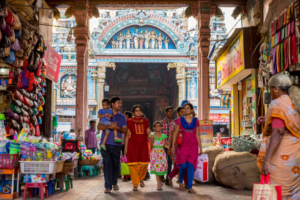Step into an Indian bazaar, and you’ll find yourself in a world where time slows down, yet everything moves at lightning speed. The air is thick with the scent of sizzling street food, the chatter of shopkeepers, and the occasional honk of a cycle rickshaw weaving through narrow alleys. These markets are not just about buying and selling; they are living, breathing entities, holding centuries of history, culture, and hidden tales!
1. Chandni Chowk, Delhi – Where History Sells Itself
In the heart of Old Delhi, Chandni Chowk is chaos personified. Every turn leads to a new discovery—silver jewelry that has seen generations, fabric shops bursting with color, and the legendary Paranthe Wali Gali, where buttery, stuffed parathas have been sizzling on iron tavas for decades. This market was designed in the 17th century by Jahanara, the daughter of Mughal Emperor Shah Jahan, and to this day, it thrives with a spirit as grand as the empire it once served.
2. Khari Baoli, Delhi – The Symphony of Spices
A short walk from Chandni Chowk, the air changes—suddenly, you’re surrounded by the earthy aroma of turmeric, the sharpness of dried chilies, and the warmth of cinnamon. Welcome to Khari Baoli, Asia’s largest spice market, where traders have been dealing in saffron, cardamom, and cloves since the 1600s. Every grain of spice here has traveled miles, carrying flavors that will find their way into kitchens across the world.
3. Johri Bazaar, Jaipur – The Glittering Gem of Rajasthan
If gemstones could talk, the walls of Johri Bazaar would hum with stories of kings, queens, and jewelers crafting masterpieces for royalty. This is where Jaipur’s legacy of gem-cutting and goldsmithing continues, with artisans still following age-old traditions. Walk a little further, and you’ll find yourself in Bapu Bazaar, famous for its mojaris (traditional Rajasthani footwear), where every pair tells a story of craftsmanship passed down through generations.

4. New Market, Kolkata – Where Time Stands Still
There’s something timeless about Kolkata’s New Market. Opened in 1874, it was once the shopping hub of British India. Today, it is a labyrinth of stalls selling everything from vintage collectibles to freshly baked Nahoum’s fruitcakes. The architecture may remind you of a forgotten colonial era, but the heart of the market beats in its generations-old shopkeepers, still calling out to customers with a warmth you won’t find in modern malls.
5. Mapusa Market, Goa – A Cocktail of Culture
Goa’s beaches may steal the limelight, but Mapusa Market is where you find the state’s true essence. Every Friday, local vendors set up stalls offering everything from homegrown spices to handwoven Kunbi sarees. The air is alive with Konkani chatter, and if you’re lucky, you might stumble upon a grandmother selling a secret-recipe Goan masala blend that’s been in her family for generations.
6. Crawford Market, Mumbai – The Pulse of the Maximum City
No market reflects Mumbai’s fast-paced energy like Crawford Market. Housed in a 19th-century colonial building, this market is a mix of old-world charm and modern-day madness. Fresh fruits, exotic pets, and stacks of books crowd the space, while vendors juggle conversations in multiple languages. It’s a place where Mumbai’s spirit—its resilience, diversity, and never-say-die attitude—comes alive in every transaction.
Markets in India are more than places of commerce; they are storytellers of tradition, heritage, and human connection. Each vendor has a tale—of struggles, of victories, of a legacy passed down. A bazaar isn’t just where things are sold; it’s where history breathes, cultures merge, and the soul of India reveals itself in its rawest, most vibrant form.
So, the next time you step into one of these bustling marketplaces, slow down. Listen to the voices, inhale the aromas, run your fingers over the fabrics, and let the market tell you its secrets. Because in India, a bazaar is never just a market—it’s an experience waiting to be lived!